Oliver Graf, Zoltán Kiss- Area Sales Manager - East Europe - Endrich GmbH.
Temperature sensors for different applications
14 March 2017

Summary :
Temperature measurement is one of the most important disciplines in sensor technology. Basically there are contactless and touchcontact measurement methods. This article will make an overview of the possible temperature sensing technologies, but covers in details only the contacting temperature measurement, where the sensor element is in thermal contact with the object of which the temperature has to be measured.
Temperaturemeasurement basics
The ability of sensing temperature in electronic circuits means the necessity to convert temperature change into measureable electric characteristics, e.g. resistance or voltage change. Several different devices and technologies exist, that make it possible for the design engineers to integrate temperature sensing functions. One of them is the thermocouple technology. Thermo-couplers consist of two connected wires made of different metals. Changes in the temperature at their junction induce a change in electromotive force (emf). This effect is called the Seebeck effect, the induced voltage is called thermal electromotive force. As temperature rises, this output emf of the thermocouple increases, even if this change is nonlinear, it could be used for temperature sensing by voltage measurement. Sensors, like thermocouples and thermopiles use the Seebeck effect to measure the temperature difference between two objects. Thermocouples are often used to measure high temperatures existing on the junction side while the tail side is kept at a reference temperature. The induced voltage measured between the two elements at tail side is proportional with the temperature difference, therefore thermocouple is a temperature-voltage transducer.
The relation between the temperature and the voltage is given by the following formula
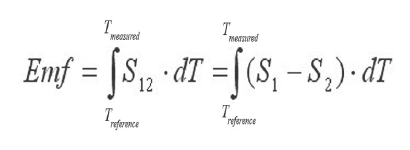
Where Emf is the electromotive force produced by the thermocouple at the tail end, Treference and Tmeasure are the temperatures of reference and measuring-end respectively, S12 is called Seebeck coefficient of the thermocouple and S1 and S2 are the Seebeck coefficient of the two metal wires.
Please keep in mind that the Seebeck coefficient depends on the material the thermo element is made of, as well as being dependent of the temperature, bringing in some nonlinearity. This temperature measurement is a differential measurement, involving the temperature to be measured and the reference temperature, which is usually the ambient temperature. In the real sensor circuit therefore there should be a cold junction compensation function implemented, which produces electromotive force equal to the thermocouple voltage between 0°C and the ambient temperature. Thermopiles use many thermocouples electrically connected in series, for sensitive measurements of very small temperature difference. Their output voltage is in the range of few tens or hundred millivolts and also suitable to sense infra red radiation, so forming a contactless sensor is also possible.

An other temperature sensor device is the so called bimetallic device. Its operation principle is based on the difference in rate of thermal expansion between different metals. Strips of two metals are bonded together, and when heated, one side will expand more than the other, the arisen force is used to e.g. switch off a circuit. These devices do not require a power supply, but they are usually not as accurate as thermocouples or other types of temperature sensors, and mainly used for acting based on temperature rise and not for measuring. The most common and important sensor elements for temperature measurement are the temperature-dependent resistors. Working principle of resistive temperature sensor devices is the dependency of the electrical resistance of a material on its temperature changes. Two main types of resistive temperature sensors are the metallic devices (mainly called resistance temperature detectors), and semi conductive temperature sensors (generally called thermistors).
The first group is characterized by resistance rising with temperature increasing, having positive temperature coefficients (PTC), and unlike the semi conductive thermistor type, their output is extremely linear producing very accurate measurements of temperature. These sensors are made of high-purity conducting metals such as platinum, copper or nickel.
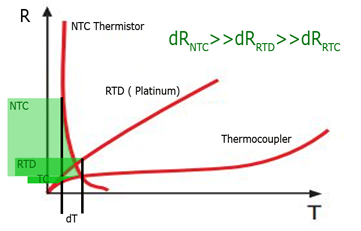
Main disadvantage of RTDs is, that they have very poor thermal sensitivity, meaning a change in temperature only produces a very small resistance change like, 1r/°C (see figure). The most common types of RTD’s are made from platinum and are called Platinum Resistance Thermometer or PRT‘ s, like the Pt1 00 sensor, which has a standard resistance value of 1 00r at 0°C. The main disadvantage of this type of device is the cost, platinum is an expensive material. A typical RTD has a base resistance of about 1 00r at 0oC, increasing to about 1 40r at 1 00°C through the operating temperature range of -200 to +600°C. As measuring temperature needs to involve sensing the voltage drop on the device, we need to pass a current through the resistor. Any variation in resistance due to I2R self heating causes an error in the readings. To avoid this, the RTD is usually connected into a Whetstone Bridge network.
Thermistors
The second group of resistive temperature sensors is the thermistor devices. Their working principle is based on non-linear resistance change in a ceramic semiconductor material with temperature rise. They are either NTCs (Negative Temperature Coefficient), which conduct the electrical current at high temperatures better than at low temperatures, or PTCs, with reverse behavior. As seen on the figure, unlike NTCs, PTCs usually have linear R-T characteristic, the advantage of the NTCs is however the better sensitivity: for the same change in temperature, the resistance change response is much more robust than with PTC or thermocouple.
The second group of resistive temperature sensors is the thermistor devices. Their working principle is based on non-linear resistance change in a ceramic semiconductor material with temperature rise. They are either NTCs (Negative Temperature Coefficient), which conduct the electrical current at high temperatures better than at low temperatures, or PTCs, with reverse behavior. As seen on the figure, unlike NTCs, PTCs usually have linear R-T characteristic, the advantage of the NTCs is however the better sensitivity: for the same change in temperature, the resistance change response is much more robust than with PTC or thermocouple.
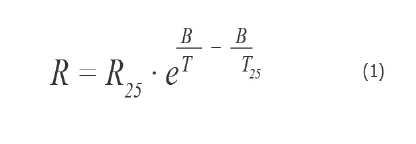
T25 = 298,15 K (25°C), T: temperature in K
R25 indicates the value of the resistance at the reference temperature of +25°C the so-called B-value (in Kelvin K) describes the behavior between resistance and temperature and determined by the following logarithmic expression:
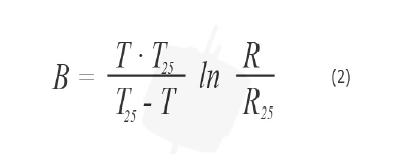
For most applications (1) provides a sufficient mathematical correlation between resistance and temperature over a wide temperature range of 0°C -1 00°C with the accuracy of ±1 °C.
For most applications (1) provides a sufficient mathematical correlation between resistance and temperature over a wide temperature range of 0°C -100°C with the accuracy of ±1 °C.

The R determines the resistance value on temperature T in (3), A, B and C are the so called Steinhart-Hart coefficients, that are derived from experimental measurements. These coefficients can be requested from the supplier of the thermistor element. This formula provides ±0.1 5°C accuracy in the temperature range of -50°C to +1 50°C, what is usually exact enough for most of the applications. By reducing the temperature range to 0°C to +1 00°C, the accuracy can be increased up to ±0.01 °C.
When designing-in an NTC temperature sensor, the driving current should be set as small as possible in order to avoid the nonlinearity caused by the I2R self heating of the sensor element. The datasheet of the supplier contains the dissipation factor, which indicates the electrical power required to heat up the thermistor by 1 °C over the ambient temperature. In practice it is recommended to stay under this threshold. Finally the NTCs has a certain thermal inertia to consider, therefore to follow temperature change by resistance change requires time. The thermal time constant „t” is defined by the elapsed time till resistance reaches 63.2% of the final value. To achieve customer and applicationspecific requirement of characteristics is always more complex task. Therefore it is crucial that the NTC manufacturer is flexible enough to give fast response to even frequently altering customer requirements. An own research and development department, and the in-house production of NTC chips is therefore mandatory for successful customer specific component design. The R25 and B values are obtained by the mixture and the added nanoparticles before the sintering process. In the Dicing-Process (separation), the wafers are separated into chips (dies) and calibrated for the further production process. The precision below ± 0.05% can be achieved in this way, without the need of selection.
Extremely high accuracy
In those applications, which require high accuracy, the long-term stability of the sensor is important. The initially low tolerance and thus a small measurement error is obvious requirement, but what happens if the resistance value drifts away over time? Main cause of this drift is the moisture that penetrates into the ceramic component. This negative affect can be prevented by glass passivation. The thick-film SMD thermistors of our Japanese manufacturer Tateyama are built on a ceramic substrate (96% Al2O3), and the thick film is provided with a glass cover protected against moisture (see image).
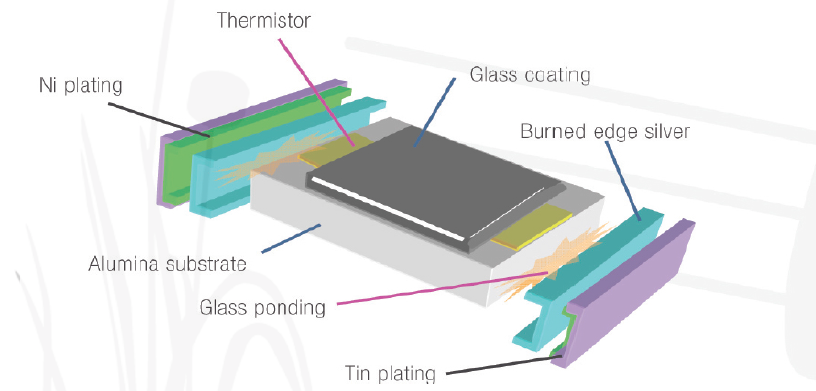
This results in a high mechanical strength against heat expansion, therefore extremely good solderability and reliability. Due to the applied glass layer it is resistive against highly corrosive gases, like e.g. sulphur as well as against moisture. The further advantage of these thick film sensors lays in the variable adjustment of the R25 – (1 00 r to 2 Mr) and B values (2700 – 5000 K) as well as in the corresponding tolerances (± 1 to ± 10 %), which is possible due to Tateyama's patented manufacturing technology. All these SMD thermistors are certified according to TS1 6949 / AEC-Q and available in the sizes of 0805 up to 0201 . Because of the price level and long-term stability, these thermistors can be used in applications such as climate control, heat cost allocators, white goods or power tools. The thick film technology can be used at temperatures up to 150°C. Smaller the form factor, the smaller is the thermal mass and thus the thermal time constant „q”. In applications where the temperature changes quickly, designer is recommended to use the smallest available device, typically the 0201 model. The NTC series from our other Japanese manufacturer Semitec are not based on the thick film, but on ceramic semiconductor technology. They are characterized by small tolerance (± 1 % in B value and R25). The sensor family with the smallest tolerance is the "AP" series (± 0.5 % in B value and R25), at temperature range of -50 to +70 °C, making possible to perform temperature measurements with an accuracy better than 0.5 K without calibration of the system. The thin "KaptonFilm" – NTCs with a thickness of only 0.5 mm are mainly used in rechargeable batteries. The "KT" family is the SMD series thermistor of Semitec. Despite its low pricing, the KT has a very good long-term stability due to the glass passivation on the surface of the ceramic chip that is required for today's electronic heat cost allocators, which are expected ten years of operation without recalibration. The "AT-4" series is widely used in handheld tools, especially the 6.8 kr type is suggested to be used in the temperature monitoring electronic of the battery charger circuit. The NTC or Platinum (Pt100-PT1000) chips made on one of the described ways can be assembled into confectioned sensors, which are then equipped with special cables (PVC, Teflon, Kynar, halogen-free, IP68 protected, Foodconform, UL-listed and so on) as well as with the application-specific connectors. Housings can be stainless steel, copper, brass or plastic according to customer requirements. These assembled temperature sensors are manufactured by our supplier TEWA.
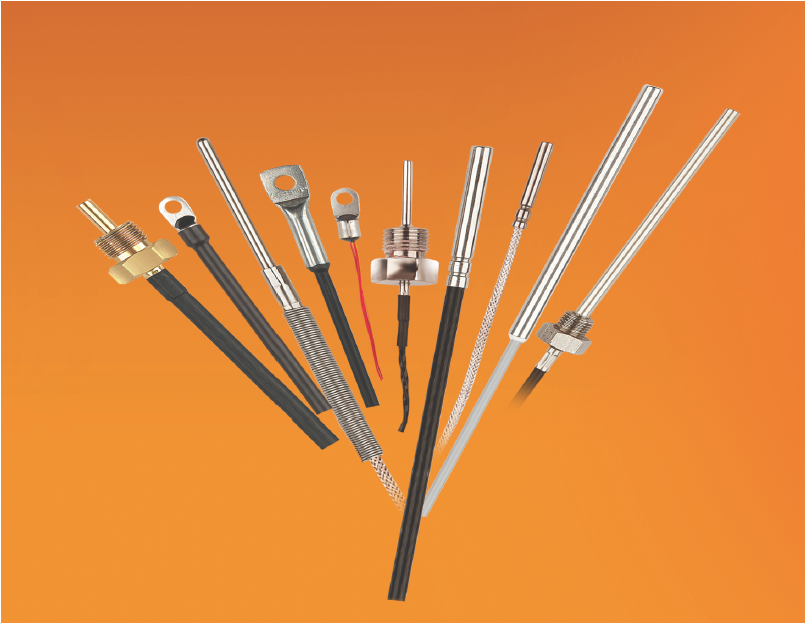
Temperature sensors may vary depending on the application requirements. Some tasks require a high measurement accuracy sensor with a small sample spread, others should work in harsh environments, where ambient temperature can reach up to +1 000 °C. In medical technology for example when measuring the blood temperature in one of the veins, the available space is critical, in a simple temperature compensation circuit the price can be critical factor.
Market trends
The market of temperature sensors has changed after recovering from the financial crisis in 2009 and shows a stable growth in different market segments. National regulations – like it became mandatory in Germany to have smoke and fire detectors in rented apartments – help a lot. Therefore, it is expected that the sales figures will grow in this market segment in the coming years. More difficult is to predict growth in the very conservative automotive industry, which is heavily dependent on exports. The trend is to move slowly towards hybrid and electric vehicle technology, which is likely to provide growth opportunities for – mainly customer specific – temperature sensors e.g. in battery packs, DC/DC converters or electric motors. In conventional car production – especially in case of diesel vehicles - the companies, like Endrich, who can offer exhaust gas temperature measurement solutions, predict good growth, as all newly registered vehicles must meet Euro 6 environmental standard. The exhaust gas analysis requires special temperature sensors, the Pt-200 element. These high temperature RTD sensors have a nominal resistance of 200 ohms at 0°C and are designed for a measuring range of -40 to +1000°C with an accuracy of ± 10 K in the temperature range of -40 to +300°C, or ± 3 K in the range of +300 to +900°C. The characteristic of the element fulfills the standards specified in DIN IEC 751 . The sensor element has special structure, forms a combination of thick and thin film technology to achieve a very good heat, as well as mechanical and thermal shock resistance. A surface protection layer makes it suitable to use as exhaust gas temperature sensor. We at Endrich Bauelemente Vertriebs GmbH are keen to offer individual and scalable design-in support for standard and customer specific temperature sensors, as we have the knowledge as well as the right supplier base for industrial, medical and automotive designs.
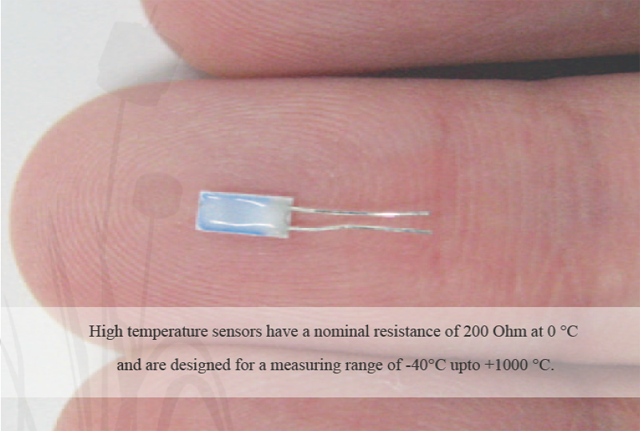
| Share on Facebook | Share on LinkedIn |
References
This article has been published on the following locations:
| # | Media | Link |
|---|---|---|
| 1 | Elektronet 2017/2 | Elektronet : elektronikai informatikai szakfolyóirat, 2017. (26. évf.) 2. sz. 26-29. old. |
| 2 | Elektronet online | Hőmérsékletszenzorok az Endrich kínálatában |
| 3 | Hungarian version | Hőmérsékletszenzorok |
| 4 | TechStory M2M | Hőmérsékletszenzorok az Endrich kínálatában |
| 5 | Revista Española de Electrónica | Elementos NTC como sensores de temperatura de uso universal |
| 6 | Magyar Elektronika online | A hőmérséklet-érzékelés eszközei |
| 7 | Magyar Elektronika 2020/5 | 2020. 5.sz. 4-8.o. |


